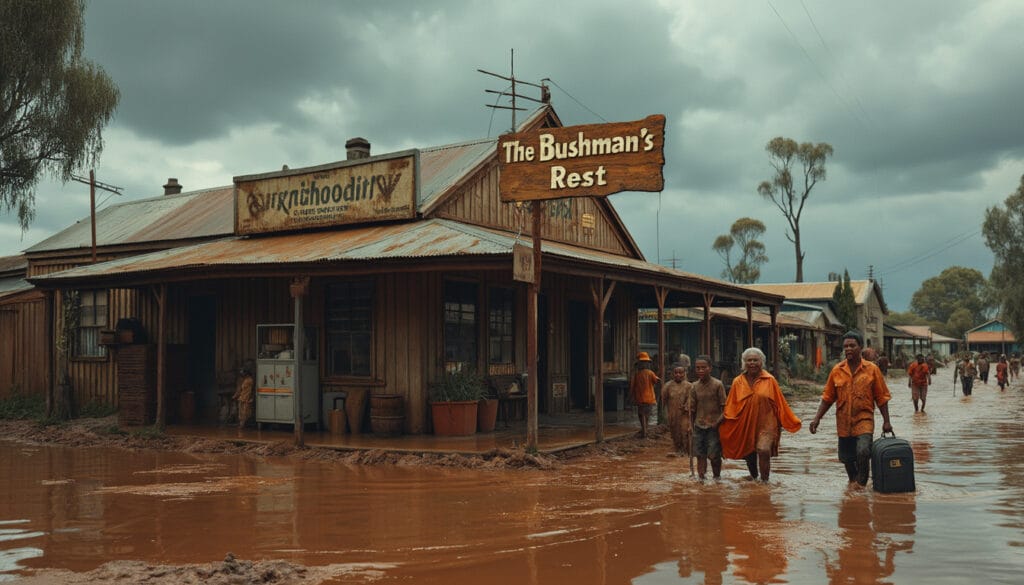The skies unleashed their fury on Adavale, turning this peaceful village into a battleground against the relentless waters. The once quiet streets are now submerged, bearing witness to nature’s devastating power. The residents, resilient despite everything, struggle to rebuild their disrupted daily lives.
Koss Siwers’ return to his pub in Adavale was a shock: everything had shifted, and a thick layer of mud covered every nook and cranny. The massive floods, extending 900 km west of Brisbane, forced the evacuation of many residents, who are now beginning to return to this small outpost. Barely arrived, Siwers noticed the damage: “It’s an absolute disaster, I’ve never seen anything like it,” he said, pointing at the scattered furniture and damaged equipment.
The State Emergency Services mobilized nearly 80 personnel to assist isolated communities, battling a flood comparable in size to New South Wales. Commissioner Chris Seng, the only police officer in Adavale, teamed up with another resident to evacuate inhabitants using a makeshift boat, risking being swept away by strong currents. Despite the challenges, Seng and his team remain determined, underscoring the resilience and solidarity of the residents in the face of disaster.
In Thargomindah, located about 300 km south of Adavale, water levels have reached historic highs, exceeding 7.5 meters and breaking the record from 1974. The community has lost over 150,000 cattle, including sheep, cows, and goats, while receiving more than 1,000 bales of hay to support the surviving animals. Relief efforts also include air deliveries of fuel and essential supplies, as well as fodder drops for isolated properties and remote stations.
Despite the losses and challenges, the residents remain determined to rebuild. Siwers expressed his desire to continue managing the local pub to support exhausted volunteers and the community, even mentioning the possibility of relocating the town if necessary. Donations from charities, although modest, play a crucial role in providing vital resources, such as beer for volunteers and affected residents.

How have the floods affected the village of Adavale?
The quiet community of Adavale, located about 900 km west of Brisbane, has recently faced devastating floods that have left indelible marks on this small village in Queensland. Returning to their village after the forced evacuation has been a major challenge for residents, confronted with unrecognizable landscapes and substantial material damage. Exceptional rainfall has led to record water levels, submerging homes and essential infrastructures.
According to reports, some areas, like Thargomindah, experienced historic flooding with water levels reaching over 7.5 meters, far surpassing the records of 1974. These massive floods not only disrupted the daily lives of residents but also severely impacted livestock, with the loss of over 150,000 sheep, cattle, and goats. The destruction of agricultural infrastructure has jeopardized local livelihoods, making recovery a daunting task.
Moreover, the scale of the flooding has isolated several communities, complicating logistics for relief efforts. The region has seen the intervention of about 80 members of the State Emergency Services (SES), deployed to help residents recover after the impact of the floods. This rapid mobilization has been essential to provide vital assistance, whether by evacuating residents to safe areas or distributing food and other essential supplies.
To learn more about the challenges posed by climate disasters, check out the article on actuaries predicting an economic slowdown of 50% due to climate shocks.
What is the current situation of the pub in Adavale after the floods?
The pub in Adavale, a central pillar of the community, sustained significant damage due to the floods. Koss Siwers, who splits his time between Adavale and Brisbane, discovered the pub covered with a thick layer of mud estimated to be between five and ten centimeters. “It’s an absolute disaster, I’ve never seen such a scene,” he stated upon seeing the damage.
Inside, the furniture was overturned, showing evidence of unexpected water force. “Everything that could float was swept away, nothing was in its place,” Siwers added. Despite these visible ravages, the building’s structure seems to have remained intact, although items such as refrigerators, freezers, and beds are irreparably damaged. The resilience of the infrastructure is a glimmer of hope for the owners, who are considering restoring the pub to serve the community again.
The reconstruction efforts will be crucial for the revival of social life in Adavale. Charity donations, particularly aimed at providing beer to exhausted volunteers and residents, will play an important role in this process. Marc, a fictional member of the community, mentions: “People are doing well, but one lady said she was considering moving to higher ground.” Therefore, the reconstruction will need to consider not only material aspects but also the emotional well-being of the residents.
For initiatives in modernizing water infrastructure, visit the European Investment Bank which is heavily investing in this area.
How is the community organizing itself in the face of floods?
In the face of floods, the Adavale community has demonstrated remarkable resilience and adaptability. Residents, while facing immense challenges, quickly mobilized local resources to support those in need. Senior Constable Chris Seng, the only police officer in Adavale, partnered with another resident to evacuate at-risk individuals using a rusty boat set aside for years. “It’s terrifying,” Seng confides, who nearly got swept away by the fast waters.
Community initiatives are not limited to evacuation efforts. Over 1,000 bales of hay have been distributed to affected areas since the beginning of the floods to help rebuild agricultural zones. Additionally, charitable donations continue to flow in, providing essential resources for the daily needs of residents. The solidarity and determination of the inhabitants are palpable, with inspiring stories of neighbors helping neighbors overcome difficulties.
To better understand the issues of reconstruction in the face of natural disasters, check out this article on resilient reconstruction.
What actions have been taken by emergency services?
The response of emergency services to the magnitude of flooding in Adavale has been swift and coordinated. With the mobilization of nearly 80 members of the State Emergency Services (SES), efforts are underway to provide immediate assistance and support long-term recovery. The resources deployed include not only personnel on the ground but also specialized equipment to manage standing water, clear debris, and ensure that residents are safe.
In addition to the SES, local authorities collaborated with police services and rescue teams to ensure complete coverage. Senior Constable Chris Seng, mentioned earlier, plays a key role in coordinating evacuations and managing local emergencies. Concurrently, government aircraft and private suppliers have been dispatched to remote areas like Longreach and Charleville to deliver fuel and essential supplies.
Coordination with external organizations is also vital to address gaps caused by the isolation of affected communities. Modernized water supplies, as well as initiatives for forecasting and managing floods, are being implemented to prevent future disasters. This close partnership between emergency services and support organizations is crucial to ensuring an effective and rapid response to emergencies.
To learn more about efforts to modernize water infrastructure, visit this article.
What are the future challenges for Adavale after the floods?
After a disaster of such magnitude, the post-flood challenges for Adavale are numerous and complex. Reconstructing the damaged infrastructure, including the traditional central pub, represents a colossal task. The community must not only repair physical structures but also rebuild the social fabric affected by the floods.
One of the main challenges lies in future resilience against extreme climate events. With increasingly uncertain weather forecasts, Adavale must adopt sustainable strategies to protect itself from such disasters in the future. This includes improving drainage systems, building resilient structures, and integrating renewable energy solutions to reduce their reliance on vulnerable infrastructures.
Another important challenge is economic support. The loss of livestock and the destruction of farmland require rehabilitation efforts to help farmers bounce back. Additionally, maintaining essential services and local businesses, such as the pub in Adavale, is crucial for the economic revitalization of the region.
Finally, mental health and the well-being of residents must be a priority. The trauma caused by the floods can have long-term effects on the community. Psychological support programs and community initiatives aimed at boosting residents’ morale are essential for ensuring a smooth recovery.
To explore how COP energy goals can be strengthened, check out this article.
How do the floods in Adavale illustrate the challenges of climate change?
The recent floods in Adavale are not an isolated incident, but part of a global trend of extreme weather events exacerbated by climate change. These natural disasters highlight the urgent need for adaptation and mitigation strategies to protect vulnerable communities. Adavale, as an isolated community, represents a microcosm of the challenges faced by many other regions.
The increasing frequency and intensity of floods can be attributed to changes in precipitation patterns and rising global temperatures. These phenomena not only elevate the risk of new extreme weather events but also exacerbate the impacts of existing disasters. Therefore, it is essential to invest in resilient infrastructure and promote sustainable practices to reduce carbon footprints.
In this context, initiatives for renewable energy become crucial. Adopting solutions such as wind energy can not only reduce reliance on fossil fuels but also offer a more sustainable alternative for isolated communities like Adavale. By integrating clean technologies, these communities can improve their resilience against the impacts of climate change.
For an in-depth analysis of the economic impacts of climate, check out this article.
What lessons can be learned from this disaster to prevent future damage?
The experience of Adavale in facing the floods offers several valuable lessons for the prevention and management of future disasters. Firstly, the importance of preparedness and planning cannot be underestimated. Communities must develop robust emergency plans, including effective evacuation protocols and early warning systems to reduce risks and human losses.
Secondly, investing in resilient infrastructure is essential. This includes not only physical structures that can withstand floods but also water management systems and green technologies to minimize environmental impacts. Integrating renewable energy solutions could also strengthen the energy autonomy of communities and reduce their vulnerability to service interruptions.
Moreover, intersectoral cooperation between governments, emergency services, non-governmental organizations, and local residents is crucial. A collaborative approach enables a more coordinated and effective response to crises, ensuring that resources and assistance are distributed equitably and in a timely manner.
Finally, education and awareness play a key role in disaster prevention. Informing residents about potential risks and best safety practices can significantly improve community resilience and minimize damage during future extreme events.
For a global perspective on reconstruction and resilience, check out this article.
What supports are available to help Adavale rebuild?
The reconstruction of Adavale will require multifaceted support, involving financial, human, and material resources. Local authorities, in collaboration with emergency services, have begun coordinating rehabilitation efforts to restore essential infrastructure and get the community back on its feet. This includes repairing roads, public buildings, and water systems, as well as restoring devastated farms.
State and federal governments have also mobilized emergency funds to help residents rebuild their homes and restart their economic activities. Grant and low-interest loan programs are being established to support affected families, facilitating their return to a normal life. Additionally, volunteers and non-governmental organizations play a crucial role by providing direct assistance and sending essential supplies for the immediate needs of residents.
Beyond governmental support, private initiatives and charity donations constitute an important source of aid. Local businesses and community partners contribute by funding reconstruction projects and providing necessary building materials. These combined efforts enable a faster and more efficient recovery, supporting the long-term resilience of Adavale.
For examples of funding and modernization of infrastructure, check out this article.
How does this situation highlight the importance of the energy transition?
The floods in Adavale underscore the crucial importance of energy transition in the context of climate change. Adopting renewable energy sources, such as wind energy, can not only reduce greenhouse gas emissions but also strengthen the energy resilience of isolated communities. Dependence on fossil fuels exposes these regions to increased vulnerabilities during natural disasters, where traditional energy infrastructures can be easily damaged.
By investing in clean energy solutions, Adavale can not only contribute to the fight against climate change but also benefit from a more stable and sustainable energy source. Renewable technologies, like wind turbines, offer a viable alternative to ensure continuous electricity supply even during major disruptions, thus ensuring better preparedness for future natural disasters.
Furthermore, the energy transition can stimulate the local economy by creating job opportunities and attracting investments in the green technology sector. This could foster sustainable economic growth and strengthen the autonomy of communities in facing climate challenges.
To understand the world’s failure to meet COP renewable energy goals, check out this article.
What is the long-term outlook for Adavale after the floods?
In the long term, Adavale has the opportunity to reinvent itself and strengthen its resilience against future climate challenges. Strategic planning and the adoption of sustainable practices will be essential to ensure the community’s sustainability. This includes not only rebuilding damaged infrastructures but also investing in green technologies and effective natural resource management systems.
Incorporating renewable energy solutions into the reconstruction can transform Adavale into a model of sustainability and energy autonomy. By investing in resilient and eco-friendly infrastructures, the community can reduce its carbon footprint and prepare to face future climate changes. Additionally, promoting sustainable agriculture and diversifying income sources can strengthen the local economy and provide greater stability for residents.
Continuous cooperation between residents, local authorities, and external partners will be critical to the success of this transition. By fostering a spirit of solidarity and innovation, Adavale can not only recover from the recent floods but also prepare for a safer and more prosperous future for generations to come.
To explore how Democrats can abandon certain policies, check out this article.
Articles similaires
Thank you!
We will contact you soon.














